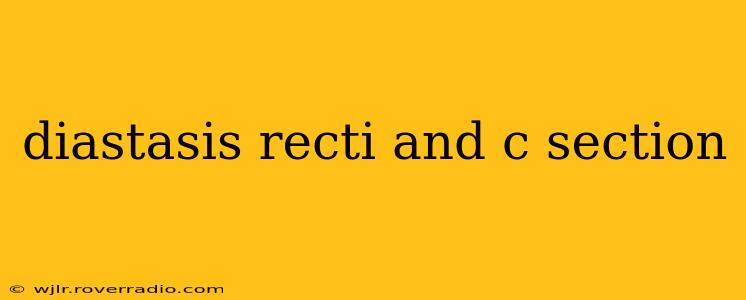Diastasis recti, the separation of the abdominal muscles, is a common postpartum condition affecting many new mothers. While it can occur after vaginal delivery, there's a strong association between diastasis recti and c-sections. This post will explore this connection, providing insights into the causes, symptoms, and treatment options. Understanding the link between diastasis recti and c-sections is crucial for expectant and postpartum mothers to ensure proper recovery and prevent long-term complications.
What is Diastasis Recti?
Diastasis recti abdominis refers to the widening of the linea alba, the connective tissue that runs down the middle of your abdomen, separating your right and left rectus abdominis muscles (the "six-pack" muscles). This separation can range from a slight gap to a significant widening, causing a noticeable bulge in the abdomen. While it's often associated with pregnancy, it can also occur in individuals who aren't pregnant, particularly those with conditions affecting abdominal wall integrity.
Does a C-Section Increase the Risk of Diastasis Recti?
While pregnancy itself significantly increases the risk of diastasis recti, research suggests that the method of delivery might play a role. Although it's not definitively concluded that C-sections cause diastasis recti more than vaginal deliveries, some studies indicate a potential correlation. The abdominal muscles undergo considerable stretching during pregnancy, regardless of delivery method. However, the surgical incision of a C-section might contribute to additional weakening or stress on the abdominal wall, potentially increasing the risk or severity of diastasis recti. More research is needed to definitively establish the extent of this contribution.
How Does a C-Section Contribute to Diastasis Recti?
The precise mechanism by which a C-section might contribute to diastasis recti isn't fully understood. However, several factors might play a role:
- Surgical Incision: The incision itself, particularly a low transverse incision (the most common type), can disrupt the integrity of the abdominal wall, leading to increased vulnerability to muscle separation.
- Post-Surgical Recovery: The recovery period following a C-section often involves restricted movement and reduced abdominal muscle engagement, potentially hindering the natural healing process and increasing the likelihood of diastasis recti.
- Hormonal Changes: The hormonal shifts associated with pregnancy and postpartum recovery affect connective tissue elasticity. These changes, in conjunction with surgical stress, could further contribute to diastasis recti.
- Increased Abdominal Pressure: Post-surgical pain and the need for coughing or straining could increase intra-abdominal pressure, potentially exacerbating muscle separation.
Can I Prevent Diastasis Recti After a C-Section?
While you can't completely eliminate the risk of diastasis recti after a C-section, some strategies might help reduce the likelihood or severity:
- Postpartum Physical Therapy: Consulting a physical therapist experienced in postpartum rehabilitation can be incredibly beneficial. They can assess the degree of separation, teach proper posture, breathing techniques, and safe exercises to strengthen the abdominal muscles.
- Gentle Exercise: Avoid strenuous abdominal exercises immediately after surgery. Instead, focus on gentle movements and core stabilization exercises recommended by your doctor or physical therapist.
- Proper Lifting Techniques: Pay close attention to proper lifting techniques to avoid putting undue strain on your abdominal muscles.
- Nutritional Support: Maintaining a balanced diet rich in protein and essential nutrients supports tissue repair and healing.
How is Diastasis Recti Diagnosed After a C-Section?
Diagnosis of diastasis recti typically involves a physical examination. Your doctor or physical therapist can assess the gap between your abdominal muscles by feeling your abdomen and checking for a visible bulge. Sometimes, ultrasound might be used for a more precise measurement of the separation.
What are the Treatment Options for Diastasis Recti After a C-Section?
Treatment options for diastasis recti vary depending on the severity of the separation and the individual's symptoms. Options include:
- Conservative Management: This usually involves physical therapy, core strengthening exercises, and posture correction.
- Surgical Repair: In cases of significant separation, persistent symptoms, or failure of conservative treatment, surgical repair might be necessary.
Will Diastasis Recti Affect My Future Pregnancies?
Having diastasis recti in one pregnancy does increase the risk of experiencing it again in subsequent pregnancies. However, proper management and strengthening of the abdominal muscles can help minimize this risk.
How Long Does it Take for Diastasis Recti to Heal After a C-Section?
Healing time varies depending on the severity of the separation and individual responses to treatment. Some women experience significant improvement within several months of focused therapy, while others may require longer-term management.
This information is for educational purposes only and is not a substitute for professional medical advice. Always consult with your healthcare provider or a qualified physical therapist for diagnosis and treatment of diastasis recti. They can provide personalized recommendations based on your individual circumstances.
